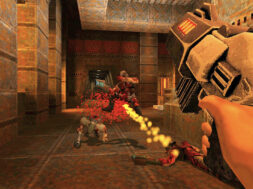
‘TerrorBytes’ Docuseries Adds Six More Participants, Extends Pre-sales Campaign Deadline to March 5
Centering a game review around comparisons to other releases can feel, at best, kind of lazy and, at worst, downright unfair. After all, even when titles do share particular traits, stylistic touchstones or behind-the-scenes talent, they’re often aiming for completely different things.
As a general rule of thumb, unless you are dealing with a blatant rip-off in the vein of The Day Before, it’s usually best to judge each work of art on its own terms. However, this is sometimes easier said than done, as certain games have become so massively influential in their respective arenas — at times codifying entire genres — that they end up being the proverbial elephant in the room whenever you’re evaluating a similar work. Take World of Warcraft, Grand Theft Auto or Dark Souls for instance.
The latter is an especially good example, as it’s become such a clear benchmark for a very specific type of action RPG (with extremely precise criteria) that when another game bears even the slightest resemblance to it, it’s almost impossible to ignore the overlap. Hence why so much of our coverage of Lords of the Fallen was spent comparing and contrasting it to FromSoftware’s seminal trendsetter. We just couldn’t grade it in a vacuum.
The Outlast Trials places us in a similar predicament. It’s a multiplayer horror title wherein a quartet of survivors have to escape deadly labyrinths by: exploiting perk abilities; lockpicking containers for resources; looping their pursuers while teammates perform key tasks; and then making a mad dash over to the timed exit gate. There are even a few occasions where you’ll have to power up a noisy generator to progress.
Comparisons to Dead by Daylight (as well as a couple of other gems like The Texas Chain Saw Massacre) are therefore inevitable. Yet, as we pointed out when the game was still in Early Access, The Outlast Trials never feels like a poor man’s DbD. On the contrary, it’s able to stand on its own as a super addictive, tightly balanced and uniquely depraved entry in the multiplayer horror canon.
Physical Therapy
Winding the clock back to long before the notorious bloodbath (and associated necrophilism) of the franchise’s debut, this spin-off takes place at the height of the Cold War and is framed very much as a precursor to the Mount Massive Asylum atrocities. Indeed, while the Murkoff Corporation eventually went down the route of experimenting on captive mental patients, they actually started out by testing some of their more barbaric theories on downtrodden vagrants whom they were sure nobody would miss.
You see, as international tensions heated up towards the end of the 1950s, various governments around the globe developed an interest in exploring the potential use of sleeper agents. The idea being that these unassuming operatives could destabilise foreign regimes from within by going deep undercover and waiting until their handlers activated them. However, it was immediately apparent that, in order for this plan to be viable, the assassins in question would need to be totally obedient; capable of following orders — no matter how deplorable they might be — without any moral qualms or pesky concerns for their own safety.
Rather than just going through a normal recruitment process then, the world powers turned to the unscrupulous lab coats (among whom were a number of ex-Nazi scientists) over at Murkoff. And the transnational corporation was more than happy to oblige, on the condition that they be given carte blanche to do whatever they wanted in the name of their research.
And, thus, the Trials were born.
In a nutshell, Murkoff’s plan was to abduct people off the street and then subject them to a series of gruelling psychological and physical tests in an underground facility. Pushing these so-called “regents” to very breaking points, the ensuing gauntlets would make participants do the most appalling things to survive, with the ultimate goal of systemically stripping them of their humanity.
Those select few who managed to withstand this torture, and thereby proved themselves worthy, were then released back into the world as brainwashed killing machines. Ready to be triggered at a moment’s notice.
Which is where you come in! Taking control of one of these would-be Manchurian Candidates, you’ll have to earn your “freedom” by successfully completing a number of grisly “therapy programmes” in the depths of Murkoff’s subterranean facility. Among other things, this will entail: dealing with raving (and oftentimes amorous) lunatics; sidestepping lethal traps; pumping yourself full of suspicious chemicals; rooting around for keys that have been sewn into cadavers; and potentially even betraying your fellow man in a dog-eat-dog fight for survival.
Trust us. It’s a lot more enjoyable than it sounds!
Getting Your Hands Dirty
What distinguishes The Outlast Trials from being yet another also-ran (in an ever-more crowded field), is that it has a real sense of identity.
While Dead by Daylight no-doubt appeals to horror aficionados — on account of its impressive track record when securing blockbuster collabs and licence acquisitions — it can sometimes feel weirdly restrained. Pop culture’s most infamous boogeymen all uniting for a crossover extravaganza should be a dream come true for us gore hounds. Yet, in reality, what you end up with is a lamer version of Resident Evil’s Nemesis who: can barely keep up with his targets; is easily stunned by a wooden panel; and must ineffectually swat at survivors until they’re downed.
That just never sat right with me. Nor was I on board with Freddy Krueger so impersonally outsourcing his kills to an extradimensional entity or the ferocious Demogorgon being content to simply maim its prey and then leave them to bleed out on a hook.
Because of Dead by Daylight’s rigid structures and mechanics, you don’t really get the authentic experience of controlling these iconic villains. Like in Fortnite, they’re all hollow representations of their true selves; beholden to pre-existing rules that ultimately neuter them. Sure, there’s an awful lot of IP, but there’s not much character.
Conversely, The Outlast Trials is unmistakably Outlast to its core, and has that signature nastiness that we’ve all come to expect from Red Barrel’s provocative franchise. As is befitting of a series that made its name trafficking in tastelessness and gross-out vulgarity, there’s plenty of shock value to go around here.
If you commit to just a half-hour play session, you’re guaranteed to see at least a couple of eviscerations, obscene blasphemies or instances of explicit nudity (often simultaneously). Nor is it uncommon to see mangled corpses arranged into lewd tableaus or some kind of grisly atrocity being visited upon someone’s private parts.
In keeping with the idea that this is all one big experiment designed to purge Regents of their empathy, the trials will even compel you to participate in the inhumanity from time to time. Rather than repeating those stale multiplayer horror objectives that have been done to death elsewhere — like rewiring electrical circuits to unlock doors or fixing up getaway vehicles — you’ll be asked to get your hands dirty. For example, one mission has you sawing off the legs of a crucified man before serving bleach to a cafeteria full of hungry orphans, while another gets you to dispose of body parts in an acid bath, and yet another forces you to escort a terrified prison snitch to the electric chair. It’s way more engaging than just fixing generators on a loop. You know, if you’re into that kind of thing.
Who Needs PVP When You’ve Got Villains Like This?
Crueller still, The Outlast Trials subtly incentivises an every-man-for-himself ethos, by skewing its post-match grading so that it’s largely governed by how much damage you receive instead of how much of a team player you’ve been. Under this system, it behooves you to be a little devious and to prioritise your own self-preservation above the needs of the wider group. That’s if you want the best rewards and the most generous helpings of XP at least.
Why risk putting yourself in harm’s way, for example, when you could use your fellow regents as bait and focus on completing the mission objectives? And why bother heading into the fray to revive a wounded companion when you can just get away scot-free?
Or course, it will sometimes be necessary to stick together — there is relative safety in numbers after all — but any alliances you forge in the therapies will be shaky at best and abandoned at the first sign of trouble. It creates a wonderfully tense atmosphere, as you’re never sure how far you can trust your supposed comrades.
In addition to complementing the narrative theme (you’re playing right into Murkoff’s hands by showing no compassion), this adds a much-needed jolt of dynamism to matches. Especially when you consider the fact that The Outlast Trials does not have an asymmetrical multiplayer component.
You see, at the time of writing, you are unable to play as the actual killers here as they’re all invariably NPCs. Which is a bold creative decision that has both its pros and its cons.
On the one hand, it might seem like a glaring omission for those accustomed to the likes of Evil Dead: The Game or Friday the 13th, where being able to control Jason or the Kandarian Demon is half the fun. And even if you’re playing as the hunted in those games, it just adds to the thrill of the chase when you know that you are being pursued by a living, breathing human.
Other gamers are highly unpredictable and (should they get into the proper role-playing spirit of things) can even be a bit mischievous in the ways they torment you. Indeed, there’s nothing quite like being hounded by a coordinated family unit in The Texas Chain Saw Massacre and, likewise, an AI-controlled enemy will never have the same personal touch as, say, a sadistic Dead by Daylight veteran.
On the flip side, because The Outlast Trials restricts itself to computer-controlled psychos only, it has the freedom to script more interesting encounters that would otherwise be impossible. For instance, there are enemies here who are totally blind — forcing you to carefully consider your noise levels when tiptoeing around them — while others take the form of traumatised regents who cower in hiding places and only lash out if you veer too close. Then you’ve got the imposters; deceptive mimics who can disguise themselves as your fellow regents and lure you into a false sense of security, before then closing the gap for a good old-fashioned stabbing.
Of course, the biggest personalities are the Prime Assets (effectively boss characters), each of whom has their own twisted kinks and unique behavioural traits that players will have to adjust to. Case in point, Leland Coyle is a fascistic cop — for whom force can never be too excessive — with a penchant for violating felons using his standard-issue electric cattle prod. Although he will occasionally stop his pursuit of “justice” to pleasure himself with that implement instead.
Meanwhile, the demented Mother Gooseberry is one of the best villains to come out of any horror game in recent memory. A dentist’s apprentice turned macabre children’s entertainer, she can honestly be quite funny when you hear her just faintly in the distance, bickering with that ventriloquist sock puppet she insists on carrying everywhere. But the shtick becomes a lot less amusing once she’s sniffed you out and readies her power drill. No matter how many matches you play, and no matter how many times you have to deal with her, she never stops being a terrifying presence.
Hopefully, the developers will add more of these Prime Assets to The Outlast Trials as it continues to evolve, because the pair that they have at launch are certainly the standout antagonists. If they’re not going to include a PvP mode further on down the line — which isn’t necessarily a deal breaker by the way — then they will need to increase the roster as well to ensure that it doesn’t go stale.
An Adrenaline-Fuelled House of Horrors
While there is certainly room for expansion, the important thing to note is that Red Barrels has absolutely knocked it out of the park when it comes to their base content. In fact, it’s hard to remember the last time that a horror multiplayer package was this fully-formed right out of the gate.
Even when it was still in early-access, we were blown away by how meticulously balanced and just plain satisfying it was from a gameplay perspective, and it’s only improved since then. You might be limited to just controlling the hapless victims, but there’s no other game we can think of that manages to make that side of things so damn enjoyable.
For a start, there’s a lot more depth to playing as a regent than you might expect. Should you get spotted by an enemy, for instance, you don’t have to tediously loop them around obstacles until they get fatigued (although that is a perfectly valid strategy). On the contrary, you’ve got quite a few different options at your disposal.
Players can lob objects to distract their pursuers or even to temporarily daze them with a well-aimed throw. You also have far greater maneuverability than you do in Dead by Daylight, allowing you to skid under tables; parkour over ledges; and give teammates a helpful boost to reach high-up places. It’s all surprisingly intuitive and results in some very suspenseful chases that are way more energetic-feeling than they are in similar releases.
Stealth is equally refined, as the devs bring a lot of tried-and-tested mechanics over from the single-player Outlast titles (like peaking around corners, hiding in lockers and using night vision to outfox killers in the dark). However, some welcome new additions are chucked into the mix as well. For example, you can now lock enemies in-or-out of rooms to buy yourself extra time when finishing tasks, while the incredibly handy pinging system enables you keep track of them even after your line of sight is broken.
Not to mention, you also have a choice of four different RIG setups that can fundamentally change how you approach certain encounters. Essentially super-abilities that work on a cool down basis, these range from a pair of X-ray goggles to a stun grenade, a healing canister and a landmine that emits a plume of blinding smoke when activated. Some RIGs are admittedly more advantageous than others, particularly if you are playing solo, but they all have their uses and give you the flexibility to find a playstyle that works for you.
Speaking of which, the progression system is pleasingly robust as well, with a generous drip feed of cosmetic and gameplay-oriented rewards to keep you plugging away at the trials. Whenever you level up, you’ll have a tactical decision to make; as you choose between investing in the skill tree for your current RIG, trying out a different power-up, or purchasing some upgrades that will enhance your character’s general physicality. In addition to this, you’ll steadily acquire cash that can be spent on various costume pieces and decorations for your spartan prison cell.
All of which adds up to a simply fantastic multiplayer experience. You’ve got diverse mission types, complimentary playstyles, desirable unlocks and the kind of gameplay that lends itself to those organic water-cooler moments you can share with friends. The game’s not even officially launched yet and we’ve already got tons of wonderful/ chaotic/ traumatising war stories to reminisce about.
Plus, while the coop side of things is outstanding, you can still have a pretty decent time playing on your lonesome. The matchmaking facilities have come along leaps and bounds since launch on PC (and crossplay is now supported as well). Nevertheless, it can be a struggle to find the exact trial you are wanting to undertake at any given moment, so it’s good to know that lone-wolfing it is a viable option.
Difficulty is scaled according to how many regents are in the session and you do get extra respawns in lieu of teammates to revive you. It’s manageable enough then, although the later trials do become increasingly hectic when you don’t have another person around to run interference. So, we wouldn’t recommend picking this up if you are steadfastly opposed to the idea of playing with others.
With that said, even if you are one of those horror multiplayer sceptics, you might be won over by The Outlast Trials’ singularly fast-paced and gruesome spin on the idea. It’s honestly been kind of a revelation for me at least.
Relentlessly entertaining and not for the faint of heart, I’d say it sets a new gold standard for this long-running franchise and for the wider genre itself.
Published by Red Barrels, The Outlast Trials launched in early access in May 2023. It will be released in full on Tuesday the 5th March for PS5, Xbox Series X|S and PC.
Review code provided by the publisher.


















